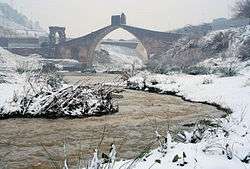Llobregat
| Llobregat | |
|---|---|
 View of the Llobregat River in Olesa de Montserrat | |
| Country | Spain |
| Physical characteristics | |
| Main source |
Serra del Cadí 1,259 m (4,131 ft) |
| River mouth |
Mediterranean Sea 0 m (0 ft) 41°17′53″N 2°08′17″E / 41.29806°N 2.13806°ECoordinates: 41°17′53″N 2°08′17″E / 41.29806°N 2.13806°E |
| Length | 170 km (110 mi) |
| Discharge |
|
| Basin features | |
| Basin size | 4,948.3 km2 (1,910.5 sq mi) |
| Tributaries |
|

The Llobregat (Catalan pronunciation: [ʎuβɾəˈɣat]) is the second longest river in Catalonia, Spain. Its name could have originated in an ancient Latin word meaning 'dark', 'sorrowful' or 'muddy', or from Rubricatus, "red."[1][2]
Course
The Llobregat originates at an elevation of 1,259 metres (4,131 ft) in the Serra del Cadí, within the limits of Castellar de n'Hug municipality, Berguedà comarca. The total length of the river is over 170 kilometres (110 mi). At Martorell, the Roman Via Augusta crosses the river on the impressive Devil's bridge, which dates from the High Middle Ages in its current form. The C-16 highway is also known as the 'Llobregat Axis' (Catalan: Eix del Llobregat) for its largest stretch follows the valley of the Llobregat.
The river ends in the Mediterranean Sea forming the Llobregat Delta, in the municipality of El Prat de Llobregat, near Barcelona. The delta provided a large extension of fertile land close to the city of Barcelona, but is now largely paved, urbanized or covered by infrastructure such as the Barcelona–El Prat Airport.[3]
The Llobregat is heavily managed in its lower course and water that was previously lost to the sea is now pumped upstream to increase the natural flow, recharge the river delta wetlands and control seawater incursion.
Tributaries
The main tributaries of the Llobregat are:
- Right tributaries:
- Left tributaries:
- Riera de Merlès
- Riera Gavarresa
- Riera de Rubí
- Riera de Vallvidrera, also known as la Rierada
See also
References
- ↑ https://www.thevisigoth.com/single-post/2016/05/12/Barcinoetymology-The-Origins-of-Barcelona
- ↑ Bofarull i Terrades, Manuel. Origen dels noms geogràfics de Catalunya: pobles, rius, muntanyes, 2002.
- ↑ La transformació del Delta
Further reading
- S. Sabater & A. Ginebreda & D. Barceló (Editors): The Llobregat: The Story of a Polluted Mediterranean River. Springer, 2012. ISBN 978-3-642-30938-0
External links

- River Llobregat Water Reclamation Project